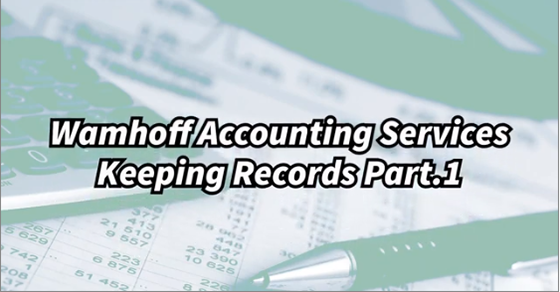It’s very important to keep good records, not only for your business, but also as an individual. In this video, Sandy Furuya goes over good record-keeping practices for your business.
Categories
- Employer Knowledge Base (17)
- Individual Taxes (327)
- News (29)
- Small Business Taxes (294)
Archives
- April 2024 (6)
- March 2024 (8)
- February 2024 (8)
- January 2024 (11)
- December 2023 (7)
- November 2023 (9)
- October 2023 (9)
- September 2023 (8)
- August 2023 (9)
- July 2023 (7)
- June 2023 (8)
- May 2023 (10)
- April 2023 (8)
- March 2023 (9)
- February 2023 (8)
- January 2023 (9)
- December 2022 (8)
- November 2022 (10)
- October 2022 (8)
- September 2022 (8)
- August 2022 (8)
- July 2022 (8)
- June 2022 (6)
- May 2022 (9)
- April 2022 (7)
- March 2022 (9)
- February 2022 (7)
- January 2022 (9)
- December 2021 (8)
- November 2021 (9)
- October 2021 (7)
- September 2021 (7)
- August 2021 (9)
- July 2021 (8)
- June 2021 (10)
- May 2021 (9)
- April 2021 (8)
- March 2021 (12)
- February 2021 (8)
- January 2021 (8)
- December 2020 (10)
- November 2020 (9)
- October 2020 (8)
- September 2020 (9)
- August 2020 (8)
- July 2020 (8)
- June 2020 (9)
- May 2020 (9)
- April 2020 (11)
- March 2020 (15)
- February 2020 (10)
- January 2020 (10)
- December 2019 (11)
- November 2019 (7)
- October 2019 (9)
- September 2019 (9)
- August 2019 (7)
- July 2019 (10)
- June 2019 (3)
- May 2019 (7)
- April 2019 (10)
- March 2019 (6)
- February 2019 (8)
- January 2019 (7)
- December 2018 (6)
- November 2018 (6)
- October 2018 (12)
- September 2018 (4)
- August 2018 (7)
- July 2018 (10)
- June 2018 (4)
- May 2018 (12)
- April 2018 (6)
- March 2018 (10)
- February 2018 (10)
- January 2018 (9)
- December 2017 (3)
- July 2016 (2)
- June 2016 (1)
- May 2016 (1)
- April 2016 (1)
- February 2016 (1)
- January 2016 (1)
- December 2015 (3)
- October 2015 (1)
- July 2015 (7)
- June 2015 (1)
Archive for July 2019 – Page 2
If you’re considering buying or selling a business — or you’re in the process of a merger or acquisition — it’s important that both parties report the transaction to the IRS in the same way. Otherwise, you may increase your chances of being audited.
If a sale involves business assets (as opposed to stock or ownership interests), the buyer and the seller must generally report to the IRS the purchase price allocations that both use. This is done by attaching IRS Form 8594, “Asset Acquisition Statement,” to each of their respective federal income tax returns for the tax year that includes the transaction.
What’s reported?
When buying business assets in an M&A transaction, you must allocate the total purchase price to the specific assets that are acquired. The amount allocated to each asset then becomes its initial tax basis. For depreciable and amortizable assets, the initial tax basis of each asset determines the depreciation and amortization deductions for that asset after the acquisition. Depreciable and amortizable assets include:
- Equipment,
- Buildings and improvements,
- Software,
- Furniture, fixtures and
- Intangibles (including customer lists, licenses, patents, copyrights and goodwill).
In addition to reporting the items above, you must also disclose on Form 8594 whether the parties entered into a noncompete agreement, management contract or similar agreement, as well as the monetary consideration paid under it.
IRS scrutiny
The IRS may inspect the forms that are filed to see if the buyer and the seller use different allocations. If the IRS finds that different allocations are used, auditors may dig deeper and the investigation could expand beyond just the transaction. So, it’s in your best interest to ensure that both parties use the same allocations. Consider including this requirement in your asset purchase agreement at the time of the sale.
The tax implications of buying or selling a business are complicated. Price allocations are important because they affect future tax benefits. Both the buyer and the seller need to report them to the IRS in an identical way to avoid unwanted attention. To lock in the best postacquisition results, consult with us before finalizing any transaction
If you’re a volunteer who works for charity, you may be entitled to some tax breaks if you itemize deductions on your tax return. Unfortunately, they may not amount to as much as you think your generosity is worth.
Because donations to charity of cash or property generally are tax deductible for itemizers, it may seem like donations of something more valuable for many people — their time — would also be deductible. However, no tax deduction is allowed for the value of time you spend volunteering or the services you perform for a charitable organization.
It doesn’t matter if the services you provide require significant skills and experience, such as construction, which a charity would have to pay dearly for if it went out and obtained itself. You still don’t get to deduct the value of your time.
However, you potentially can deduct out-of-pocket costs associated with your volunteer work.
The basic rules
As with any charitable donation, to be able to deduct your volunteer expenses, the first requirement is that the organization be a qualified charity. You can check by using the IRS’s “Tax Exempt Organization Search” tool at https://www.irs.gov/charities-non-profits/tax-exempt-organization-search.
If the charity is qualified, you may be able to deduct out-of-pocket costs that are unreimbursed; directly connected with the services you’re providing; incurred only because of your charitable work; and not “personal, living or family” expenses.
Expenses that may qualify
A wide variety of expenses can qualify for the deduction. For example, supplies you use in the activity may be deductible. And the cost of a uniform you must wear during the activity may also be deductible (if it’s required and not something you’d wear when not volunteering).
Transportation costs to and from the volunteer activity generally are deductible — either the actual expenses (such as gas costs) or 14 cents per charitable mile driven. The cost of entertaining others (such as potential contributors) on behalf of a charity may also be deductible. However, the cost of your own entertainment or meal isn’t deductible.
Deductions are permitted for away-from-home travel expenses while performing services for a charity. This includes out-of-pocket round-trip travel expenses, taxi fares and other costs of transportation between the airport or station and hotel, plus lodging and meals. However, these expenses aren’t deductible if there’s a significant element of personal pleasure associated with the travel, or if your services for a charity involve lobbying activities.
Recordkeeping is important
The IRS may challenge charitable deductions for out-of-pocket costs, so it’s important to keep careful records and receipts. You must meet the other requirements for charitable donations. For example, no charitable deduction is allowed for a contribution of $250 or more unless you substantiate the contribution with a written acknowledgment from the organization. The acknowledgment generally must include the amount of cash, a description of any property contributed, and whether you got anything in return for your contribution.
And, in order to get a charitable deduction, you must itemize. Under the Tax Cuts and Jobs Act, fewer people are itemizing because the law significantly increased the standard deduction amounts. So even if you have expenses from volunteering that qualify for a deduction, you may not get any tax benefit if you don’t have enough itemized deductions.
If you have questions about charitable deductions and volunteer expenses, please contact us.
During your working days, you pay Social Security tax in the form of withholding from your salary or self-employment tax. And when you start receiving Social Security benefits, you may be surprised to learn that some of the payments may be taxed.
If you’re getting close to retirement age, you may be wondering if your benefits are going to be taxed. And if so, how much will you have to pay? The answer depends on your other income. If you are taxed, between 50% and 85% of your payments will be hit with federal income tax. (There could also be state tax.)
Important: This doesn’t mean you pay 50% to 85% of your benefits back to the government in taxes. It means that you have to include 50% to 85% of them in your income subject to your regular tax rates.
Calculate provisional income
To determine how much of your benefits are taxed, you must calculate your provisional income. It starts with your adjusted gross income on your tax return. Then, you add certain amounts (for example, tax-exempt interest from municipal bonds). Add to that the income of your spouse, if you file jointly. To this, add half of the Social Security benefits you and your spouse received during the year. The figure you come up with is your provisional income. Now apply the following rules:
- If you file a joint tax return and your provisional income, plus half your benefits, isn’t above $32,000 ($25,000 for single taxpayers), none of your Social Security benefits are taxed.
- If your provisional income is between $32,001 and $44,000, and you file jointly with your spouse, you must report up to 50% of your Social Security benefits as income. For single taxpayers, if your provisional income is between $25,001 and $34,000, you must report up to 50% of your Social Security benefits as income.
- If your provisional income is more than $44,000, and you file jointly, you must report up to 85% of your Social Security benefits as income on Form 1040. For single taxpayers, if your provisional income is more than $34,000, the general rule is that you must report up to 85% of your Social Security benefits as income.
Caution: If you aren’t paying tax on your Social Security benefits now because your income is below the floor, or you’re paying tax on only 50% of those benefits, an unplanned increase in your income can have a significant tax cost. You’ll have to pay tax on the additional income, you’ll also have to pay tax on (or on more of) your Social Security benefits, and you may get pushed into a higher tax bracket.
For example, this might happen if you receive a large retirement plan distribution during the year or you receive large capital gains. With careful planning, you might be able to avoid this tax result.
Avoid a large tax bill
If you know your Social Security benefits will be taxed, you may want to voluntarily arrange to have tax withheld from the payments by filing a Form W-4V with the IRS. Otherwise, you may have to make estimated tax payments.
Contact us to help you with the exact calculations on whether your Social Security will be taxed. We can also help you with tax planning to keep your taxes as low as possible during retirement.
Sign up for our Newsletter!
"*" indicates required fields
News & Articles
Client Portal
Contact Us
© Wamhoff Accounting Services | All Rights Reserved | Privacy Policy | Terms of Use | 636-573-1250 | Email Us




